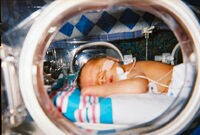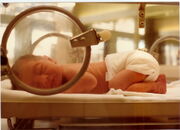Assessment |
Biopsychology |
Comparative |
Cognitive |
Developmental |
Language |
Individual differences |
Personality |
Philosophy |
Social |
Methods |
Statistics |
Clinical |
Educational |
Industrial |
Professional items |
World psychology |
Clinical: Approaches · Group therapy · Techniques · Types of problem · Areas of specialism · Taxonomies · Therapeutic issues · Modes of delivery · Model translation project · Personal experiences ·
This is a background article. See Psychological aspects of intensive care.

A newborn infant sleeping in his incubator.
A neonatal intensive care unit, usually shortened NICU and also called a newborn intensive care unit, special care baby unit (SCBU, especially in Great Britain), is a unit of a hospital specializing in the care of ill or premature newborn infants. Many Canadian hospitals have a special care nursery (SCN) for the care of premature infants, while infants and children requiring intensive care for illness or injury which cannot be treated in a standard hospital are transferred to the nearest children's hospital, where pediatric intensive care units (PICU) are separate from the SCN.
NICUs were developed in the 1950s and 1960s by pediatricians to provide better temperature support, isolation from infection risk, specialized feeding, and access to specialized equipment and resources. Infants are cared for in incubators or "open warmers." Nearly all are attached to various types of monitors. Some require respiratory support ranging from extra oxygen (by head hood or nasal cannula) to continuous positive airway pressure (CPAP) or mechanical ventilation. Public access is limited, and staff and visitors are required to take precautions to reduce transmission of infection. Nearly all children's hospitals have NICUs, but they can be found in large general hospitals as well.
A NICU is typically directed by one or more neonatologists and staffed by nurses, nurse practitioners, resident physicians, and respiratory therapists. Many other ancillary services are necessary for a top-level NICU. Other physicians, especially those with "organ-defined" specialties often assist in the care of these infants.
Early years
Doctors took an increasing role in childbirth from the eighteenth century onwards. But the care of newborn babies, sick or well, remained largely in the hands of mothers and midwives. Some baby incubators, similar to those used for hatching chicks, were devised in the nineteenth century. In the United States these were shown at commercial exhibitions, complete with babies inside. But it was not until after the Second World War that special care baby units (SCBUs) were established in many hospitals. In Britain, early SCBUs opened in Birmingham and Bristol. At Southmead Hospital, Bristol, initial opposition from obstetricians lessened after quadruplets born there in 1948 were successfully cared for in the new unit. More resources became available - the first unit had been set up with £100. Most early units had little equipment and relied on careful nursing and observation. Incubators were expensive so the whole room often was kept warm instead. Cross-infection between babies was greatly feared. Strict nursing routines involved staff wearing gowns and masks, constant hand washing and minimal handling of babies. Parents were sometimes allowed to watch through the windows of the unit. Much was learned about feeding - frequent, tiny feeds seemed best - and breathing. Oxygen was given freely until the end of the 1950s, when it was shown that the high concentrations reached inside incubators caused some babies to go blind. Monitoring conditions in the incubator, and the baby itself, was to become a major area of research.
Increasing technology

Neonatal intensive care unit from 1980
By the 1970s SCBU's were an established part of hospitals in the developed world. In Britain, some early units ran community programmes, sending experienced nurses to help care for premature babies at home. But increasingly technological monitoring and therapy meant special care for babies became hospital-based. By the 1980s, over 90% of births took place in hospital anyway. The emergency dash from home to SCBU with baby in a transport incubator had become a thing of the past, though transport incubators were still needed. Specialist equipment and expertise were not available at every hospital, and strong arguments were made for large, centralised SCBUs. On the downside was the long travelling time for frail babies and for parents. A 1979 study showed that 20% of babies in SCBUs for up to a week were never visited by either parent. Centralised or not, by the 1980s few questioned the role of SCBUs in saving babies. Around 80% of babies born weighing under 1.5kg now survived, compared to around 40% in the 1960s. From 1982 in Britain pædiatricians could train and qualify in the sub-speciality of neonatal medicine.
Not only careful nursing, but also new techniques and instruments now played a major role. As in adult intensive care units, the use of monitoring and life support systems became routine. These needed special modification for small babies, whose bodies were tiny and often immature. Adult ventilators, for example, could damage babies lungs and gentler techniques with smaller pressure changes were devised. The many tubes and sensors used for monitoring the baby's condition, blood sampling and artificial feeding made some babies scarcely visible beneath the technology. Furthermore, by 1975, over 18% of newborn babies in Britain were being admitted to SCBUs. Some hospitals admitted all babies delivered by caesarian section, or under 2500g in weight. The fact that these babies missed early close contact with their mothers was a growing concern. As in other area of medicine, the 1980s saw questions being raised about the human, and the economic costs of too much technology. Admission policies gradually changed.
Changing priorities
SCBUs now concentrate on treating very small, premature or sick babies. Some of these babies are from multiple births, often following the use of fertility drugs, but most are still single babies born too early. Premature labour, and how to prevent it, remain perplexing problems for doctors.
Over the last 10 years or so, SCBUs have become much more 'parent friendly', encouraging maximum involvement with the babies. Routine gowns and masks have gone and parents are encouraged to help with care as much as possible. Cuddling, and skin-to-skin contact are seen as beneficial for all but the frailest (very tiny babies are exhausted by the stimulus of being handled). Less stressful ways of delivering high-technology medicine to tiny patients have been devised - stick-on sensors to measure blood oxygen levels through the skin, for example, and ways of reducing the amount of blood taken for tests.
Some major problems of the SCBU have almost disappeared. Exchange transfusions, in which all the blood is removed and replaced, little by little, are rare now. Rhesus incompatibility (a difference in blood groups) between mother and baby is largely preventable. Breathing difficulties and brain haemorrhage still claims babies' lives and are the focus of many current research projects.
The long term outlook for babies saved by SCBUs has always been a concern. From the early years, it was reported that a higher proportion than normal grew up with disabilities, including cerebral palsy and learning difficulties. Now that treatments are available for many of the problems faced by tiny or immature babies in the first weeks of life, long-term follow-up, and minimising long-term disability, are major research areas.
Besides prematurity and extreme low birth weight, common diseases cared for in a NICU include perinatal asphyxia, extreme cases of preeclampsia/eclampsia, major birth defects, sepsis, neonatal jaundice, and respiratory distress syndrome due to immaturity of the lungs. Complications of extreme prematurity may include intracranial hemorrhage, chronic bronchopulmonary dysplasia (see Infant respiratory distress syndrome), or retinopathy of prematurity. An infant may spend a day of observation in a NICU or may spend many months there.
Neonatology and NICUs have greatly increased the survival of very low birth weight and extremely premature infants. In the era before NICUs, infants of birth weight less than 1400 grams (3 lb, usually about 30 weeks gestation) rarely survived. Today, infants of 500 grams at 26 weeks have a fair chance of survival.
The NICU environment provides challenges as well as benefits. Stressors for the infants can include continual light, a high level of noise, separation from their mothers, reduced physical contact, painful procedures, and interference with the opportunity to breastfeed. A NICU can be stressful for the staff as well. A special aspect of NICU stress for both parents and staff is that infants may survive, but with damage to the brain or eyes.
NICU rotations are essential aspects of pediatric and obstetric residency programs, but NICU experience is encouraged by other specialty residencies, such as family practice, surgery, and emergency medicine.
Psychological support for staff
Psychological support for parents and the wider family
See also
- Intensive Care Unit
- Neonatology
External Links
- Life in the NICU: what parents can expect
- Equipment used in the NICU -- interactive parent friendly information
| This page uses Creative Commons Licensed content from Wikipedia (view authors). |